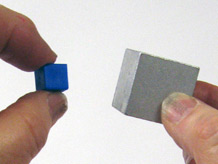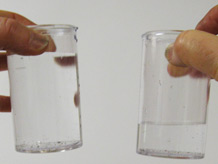Same volume, same weight?
1. Ask the question
Review the concept of volume
Get students talking about volume.
When you hear the word ‘volume’ what do you think about?
Other ideas about volume: When they first hear the word "volume," many students will think about the loudness of sound, or about volumes of books. Some students may offer a formula for calculating volume, e.g. height x width x length.

Acknowledge that the term volume has different meanings, and that knowing how to calculate volume is important. Explain that at this time we're talking about volume as the amount of 3-dimensional space that an object takes up.
Students typically confuse volume with measurements such as area or perimeter. Ask students explicitly to contrast area and volume. How are they different.
The brief demonstration below will help establish the difference between area and volume or 3-D space.
1. Show the class an unopened ream of 8.5 in. x 11 in. paper and ask students to identify some objects that have a volume that is less than the ream of paper - objects that take up less 3-dimensional space than the ream of paper. Their responses can help you gain insight into their grasp of the concept of volume.
2. Ask students to identify objects that have a volume greater than the ream of paper.
Note: Students may identify objects made of two or more materials, such as a container filled with a soft drink, or an object that includes air, such as a basketball. Those are acceptable examples, as long as you clarify that the volume of the object includes the volume of the aluminum and the volume of the soda, or the volume of the leather basketball and the volume of the air that is inside of it.
- How many of these reams of paper can I fit into my pocket?
- None. The volume of my pocket is less than the volume of the ream.
- How many of these reams can you fit into a backpack?
- Two? Three? Four?
3. Place the ream of paper flat down on a desk that all students can see, and point out that the ream is now covering part of the surface area of the desk. The ream still has its volume. That has not changed.
4. Rotate the ream so that the 2-3/4 in. x 11 in. side is on the desk surface.
- Is the ream of paper now covering more or less of the desk's surface area?
- Less
- Has the volume of the ream of paper increased, stayed the same, or decreased?
5. Summarize: Volume refers to 3-dimensional space; surface area refers to flat, 2-dimensional space. The flat top of the desk has a surface area. Each of the six faces of the ream of paper has a surface area. The ream of paper can cover different amounts of the desk's surface, depending on how the ream is placed on the desk. The amount of 3-dimensional space that the ream takes up remains the same, no matter which way we turn it or how much of the desk's surface area the ream covers.

Show the two containers that hold different volumes of water.
- How do the volumes of water in these two containers compare?
Show the container filled with sand and the container filled with organic soil.
How do the volumes of sand and organic soil compare?
Which one weighs more? How can we tell?
Introduce the investigation question
Today's investigation question is:
Same volume, same weight?
Show the class two containers, one holding 40 cc's of sand and one holding 40 cc's of organic soil.
- What do you think? If samples of different materials have the same volume, do they have the same weight?



